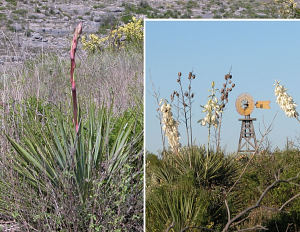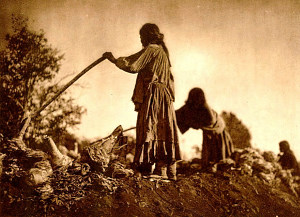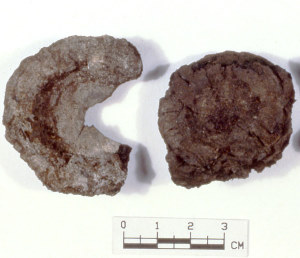The rich archeological evidence from the Lower Pecos Canyonlands in southwest Texas reveals how native peoples who lived in the region throughout prehistoric times made use of many different wild plants for food, medicine, tools, construction, ritual, and fuel. This special exhibit is a teaching and research tool for those who seek to understand the intimate links between plants and people. Many of these plants are also found in adjacent regions and were utilized by native groups across much of the Edwards Plateau, the Trans-Pecos Mountains and Basins, and the South Texas Plains, as well as northern Chihuahua and Coahuila in Mexico. Some of the same plants and closely related species occur far beyond the region in distant areas of North America and Mexico. The 38 gallery entries in this exhibit may be a bit technical, but scientific details and references are necessary for serious students of ethnobotany (as well as botany, archeology, and natural history). Elsewhere on this website additional illustrated discussions of plants typically used by prehistoric peoples appear in the "Nature's Harvest" sections of three regional exhibit sets: Plateaus and Canyonlands, South Texas Plains, and Trans-Pecos Mountains and Basins. These sections include partially overlapping entries for some of the same plants presented in this exhibit, as well as many entries for other plants, some of which also can be found in the Lower Pecos Canyonlands. Many of the plants that were used by the Native American peoples of Texas occur in broad areas of the state. The Ethnobotany of the Lower Pecos Canyonlands exhibit is sponsored by the Amistad National Recreation Area of the National Park Service (ANRA-NPS) and is in part based on the results of two research projects: an ongoing complete inventory of the NPS artifact collections from archeological sites studied within the Amistad Reservoir area (see Before Amistad) and an inventory of the plant life now present in the Amistad area. Ethnobotany is the study and description of the traditional knowledge and use of plants by native peoples. Such studies often are carried out by a botanist (plant scientist) who has worked with, and learned from, native plant experts such as traditional healers. Unfortunately, the native groups whose direct ancestors lived in the Lower Pecos area over thousands of years for generation upon generation did not survive the tumultuous period of European exploration and colonization. Yet, the dry rockshelters and caves of the Lower Pecos Canyonlands contain abundant and often fascinating evidence of plant use by the native peoples who frequented the region in prehistoric times. Fortunately, some native groups who made use of certain of the plants (or related species) found in the Lower Pecos Canyonlands did survive in northern Mexico, the American Southwest and elsewhere in North America. Understanding how ancient peoples made use of the diverse plants that grow in the Lower Pecos canyonlands requires knowledge of both natural and cultural history and an interdisciplinary research approach called paleoethnobotany. This scientific subdiscipline investigates the botanical record from archeological sites. Its typical practitioner is a professional archeologist who has strong training in both botany and ecology, a rare and challenging combined field of expertise. The paleoethnobotanist seeks to identify and interpret plant remains found in archeological sites and explore the complex interrelations among people and plants. This includes studying how native people used plants for food, shelter, clothing, medicine, ceremony, and religious ritual. It also can include how people manipulated or managed undomesticated plants in the landscape, and, in some regions, how native groups domesticated and cultivated plants (agriculture). The interdisciplinary nature of paleoethnobotany requires its practitioners to draw on many sources and to investigate both natural resource collections as well as cultural resource collections (archeological and ethnographic collections). The present study has tapped into both, using the information gained from archeological collections to guide the direction and course of the research and point the way toward future research needs. The plant-by-plant presentation format used in the Lower Pecos Ethnobotany Gallery is similar to that of the classic ethnobotanical studies, People of the Desert and Sea: Ethnobotany of the Seri Indians and Food Plants of the Sonoran Desert. There is, however a distinct difference. Whereas those published studies rely heavily on ethnographic accounts of how native peoples use plants today and in the recent past, this online gallery also tries to explain how the prehistoric groups in the Lower Pecos Canyonlands used plants thousands of years ago. The ancient history of plant use is being reconstructed by analyses of the plant remains found in the archeological collections housed in various institutions in Texas and throughout the United States. The largest and most important Lower Pecos research collection is that of the Amistad National Recreation Area (NPS) housed at the Texas Archeological Research Laboratory. The archeological record is sometimes even richer than that of the ethnographic record because ancient peoples made use of a greater variety of plants than do surviving native peoples in the modern world. A paleoethnobotany informed by both historic and prehistoric sources is indeed rich and deep. Perhaps this exhibit will help inspire students of both natural history and cultural history to conduct their field work with a greater appreciation for the wealth of plant knowledge held by the foragers who lived in the Lower Pecos Canyonlands for thousands of years. There is much more that can be learned. |
|




